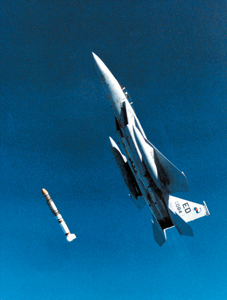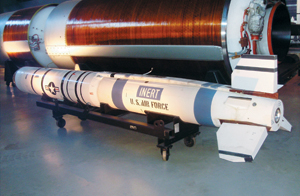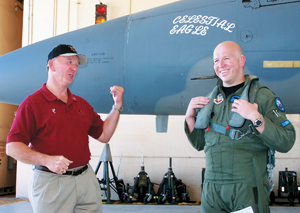On Sept. 13, 1985, Maj. Wilbert D. Pearson Jr. took off on a flight that required him to follow an extraordinarily exacting mission profile.
Pearson, an Air Force test pilot, flew his F-15A from Edwards AFB, Calif., to a point some 200 miles west of Vandenberg AFB, Calif. Then, while traveling at Mach 1.2, he pitched the fighter upward into a precise 65-degree climb, in the process pulling 3.8Gs. Pearson’s fighter rose rapidly.
Then, at an altitude of exactly 38,100 feet, the F-15 automatically launched an experimental two-stage missile called the ASM-135. The missile streaked upward, rocketing through the troposphere and stratosphere. It reached space at some 335,000 feet—more than 62 miles above Earth’s surface—and kept going.
 |
An F-15A launches an ASM-135 ASAT missile on Sept. 13, 1985. |
The missile was a squat, high-tech projectile, but its warhead carried no high explosives. Rather, this mission called for it to destroy a satellite by means of violent collision.
The ASM-135 did just that, slamming into an obsolete military observation satellite some 345 miles (1.8 million feet) above the Pacific Ocean, turning it into a cloud of metal shards and dust.
Pearson, in that moment, became the first pilot ever to shoot down a space target. Never again has the Air Force fired a missile at a satellite.
Years earlier, the Washington Post’s defense correspondent had helped put the ASM-135 into the public consciousness. George C. Wilson, in several 1977 articles, offered the first descriptions of the system and gave it a distinctive moniker—the flying tomato can.
The homing vehicle was a short cylinder that bore more than a faint resemblance to, yes, a tomato can. Fifty-six full-charge and eight half-charge solid rocket motors were arranged around its circumference, for steering. Target acquisition was the job of an infrared seeker in the center.
To work properly, the infrared seeker had to be cooled considerably before deployment. For this, it sat in liquid helium chilled to about -450 degrees Fahrenheit, or near absolute zero.
The ASAT test program required a large helium dewar, or flask, that was “about the size of the robot on the old ‘Lost in Space’ TV show,” according to Gregory Karambelas, who as a young Air Force officer worked on the ASAT program for four years. Test program F-15s were originally two-seat Eagles with their backseats replaced with helium dewars, Karambelas wrote.
The homing vehicle could only point itself in the direction of a target. It had no real forward thrust capability of its own. Thus the release point of the F-15 pilot and the performance of the booster stages were crucial to success.
The delivery aircraft had to fly to an area below the path of an oncoming target satellite. Then, after having pulled itself into a steep climb, the fighter had to release its weapon inside a very small launch window.
“If all went well, the homing vehicle would vector itself directly into the target’s path and destroy it by smashing directly into it,” said Air Force Flight Test Center historian Raymond L. Puffer. “At the extremely high closing speeds of the two objects, no explosives would be necessary.”
The first captive-carry flight of the new ASAT weapon occurred on Dec. 21, 1982. Two free-flight tests took place in 1984. The first of these was on Jan. 21 and was a success, though it did not include a miniature homing vehicle. The second test, on Nov. 2, used a star as a target for the homing vehicle’s sensor, and was judged by the Air Force to be only a partial success.
Some months later, officials concluded that they were ready to carry out a test against a real target in space. President Reagan gave his approval on Aug. 20, 1985. Originally, the shot was scheduled for Sept. 4, but Congressional restrictions at the time required that lawmakers be notified 15 days in advance. The flight was delayed nine days.
 |
The “flying tomato can” on display at the National Air and Space Museum Steven F. Udvar-Hazy Center in Virginia. |
The target was a spacecraft known as Solwind P78-1, a gamma ray spectroscopy satellite launched in 1979. Its purpose had been study of the solar wind, among other things.
At 1:42 p.m. local Pacific time, on Sept. 13, 1985, the ASM-135 fired by Pearson hit P78-1 dead on. Pentagon officials were jubilant. Secretary of Defense Caspar W. Weinberger called the test “a great step forward.”
Oddly enough, P78-1 was not an entirely burnt-out case. Naval Research Laboratory physicists were still using its data at the time. In fact, the NRL physicists who showed up at work on Sept. 14 were surprised to learn that they would no longer receive data from P78-1, according to a Los Angeles Times article at the time. The spacecraft’s major work had been completed, but “the satellite was doing several experiments,” observed a Navy spokesman, Capt. Brent Baker.
Following Pearson’s flight, Congress banned further anti-satellite shots against orbiting targets. Lawmakers disagreed with the Reagan Administration over the need for an ASAT weapon and worried it might stimulate a Soviet program or throw up additional roadblocks to strategic arms control.
The politics of arms control, plus cost overruns and technical glitches, eventually killed the program. The Pentagon canceled the ASM-135 in 1988. Yet the ASAT missile was “a major technical achievement,” according to AFFTC historian James O. Young.
Young, in a history of the center published in 2007, wrote that Pearson’s direct hit on the satellite was “a stunning event,” one that “reportedly reverberated through the halls of the Kremlin.”
The issue of space security is now receiving renewed attention, due in part to China’s test of an ASAT system in January 2007 and the US Navy’s February 2008 destruction of an ailing US spy satellite with a ship-fired missile.
Vulnerability in Space
From the dawn of the space age, both the Soviet Union and the United States worked diligently to develop capabilities to attack their adversary’s orbiting assets.
For their part, the Soviets were driven by what they perceived as the threat of US reconnaissance satellites. The Americans started emphasizing these spies in the sky in the early 1960s, after it became clear that the USSR would be able to shoot down overflying U-2s.
Soviet officials were so irritated by the recon satellites that they attempted to get the UN to condemn them as incompatible with mankind’s peaceful objectives for outer space. Soviet scientists then also set to work on methods of satellite destruction.
The USSR’s main system was the Co-Orbital ASAT, a sort of giant hand grenade for space.
Launched via conventional missile, the 1.5-ton Co-Orbital interceptor lurked in orbit close to its target. Guided by onboard radar, this killer satellite would edge closer and closer to its intended target and then detonate when the target was within about half a mile.
In its initial test phase, which ran from 1963 to 1972, this system intercepted seven targets during 20 attempts, and detonated five times.
The US had come to rely on spy satellite intelligence and thus was alarmed by the Co-Orbital ASAT. Officials also worried the Soviets would launch orbiting nuclear weapons.
“This created a sense of paranoia about our vulnerability in space,” said retired USAF Gen. Thomas S. Moorman Jr., former vice chief of staff and commander of Air Force Space Command, at a 1995 symposium on the development of space systems and their military applications.
The US had begun working on its own ASAT designs in the late 1950s. The first was Bold Orion, a two-stage rocket fired from a B-47 bomber. This came within four miles of its intended target, which was within expectations, but eventually the Air Force lost interest in the program.
In the early 1960s, the US fielded two ground-based ASAT systems.
The Army’s Program 505 used Nike Zeus missiles originally developed as anti-ballistic missile weapons.
The Air Force’s Program 437 used Thor missiles as its base.
Neither system depended on pinpoint accuracy—they employed the destructive power of nuclear warheads.
Program 505, based on Kwajalein Atoll in the Pacific, went operational on Aug. 1, 1963. It stood on alert for a year—then was abandoned by Defense Secretary Robert S. McNamara in favor of the Air Force’s effort.
Program 437 was based on Johnston Island in the Pacific. Three of four test flights (without live warheads) were successful, and the system was declared fully operational on June 1, 1964.
But after the system was up and running, US scientists began to learn more about the possible deleterious effects of nuclear explosions in space. Tests demonstrated that the electromagnetic pulse from a nuclear explosion traveled a considerable distance. Any attempt to destroy an orbiting Soviet target thus risked unintended destruction of US satellites as well.
In addition, the threat of USSR nuclear weapons in orbit had not materialized. In late 1970, Project 437 was downgraded from alert status to 30-day notice. In April 1975, the launch facilities on Johnston Island were deactivated. Project 437 was abandoned.
“I terminated that project during my tenure as Secretary of the Air Force because I did not see a good match between the likelihood of its eventual use and the cost of maintaining it,” said John L. McLucas, who led the service from May 1973 to November 1975, at the 1995 Air Force Historical Foundation symposium.
The next move was by President Ford. Concerned about the increasing US reliance on space systems for national security, Ford in 1976 issued National Security Decision Memorandum 333, which called for development of ASATs “commensurate with planned use in crisis and conflict.”
The era of US kinetic-kill anti-satellite systems was born.
Project Spike was the first effort. It involved a two-stage missile launched from an F-106. In space, the missile would release a terminal homing vehicle, which would be guided by solid rocket motors to smash a target.
Project Spike did not progress to development. But in 1978, its concept, and some of its technology, was adopted by a new program initially designated the Prototype Miniature Air-Launched System (PMALS).
PMALS was run out of the Air Force Systems Command’s Space Division. Its mission was to build a weapon able to destroy satellites in low Earth orbit.
In 1979, work began on a new Air-Launched Miniature Vehicle ASAT. It also used a two-stage, high-speed missile, launched from a fighter. However, the chosen airframe was the then-new F-15 instead of the aging F-106.
The ASAT’s first stage was a modified Boeing anti-radiation missile. Its second stage was an LTV Aerospace Altair 3. The third stage, the miniature homing vehicle itself, was also an LTV product, derived from an older effort funded by the US Army and tested against tanks.
From the inception of the program, the ASM-135 ASAT had been enmeshed in a Washington policy debate over whether the US needed such a system—and whether an arms deal with the Soviets that would limit ASAT weaponry was in the national interest.
Some critics felt that a US ASAT could destabilize the delicate balance of superpower nuclear deterrence. A Soviet leadership blinded by loss of its intelligence satellites might fear the worst and lash out with a nuclear strike, went this theory.
Others felt that the US, with its more sophisticated satellite systems, could potentially reap a disproportionate gain from an ASAT arms control pact.
 |
Retired Maj. Gen. Doug Pearson (l) and his son, Capt. Todd Pearson (r), discuss a Sept. 13, 2007 flight commemorating the historic satellite kill. For the event, Captain Pearson flew the same F-15A his father had flown 22 years before. |
Another Arms Race
The Carter Administration had conducted three rounds of ASAT talks with the Soviets before the US suspended all superpower arms negotiations following the USSR’s invasion of Afghanistan.
During the Reagan era, the subject of ASATs was addressed in ongoing defense and space talks, but Reagan officials were skeptical of the benefits of such negotiations.
The closed Soviet society made verification of arms deals in general very difficult. “This problem is aggravated for ASAT systems because the satellites which serve US and allied security are few in number,” judged a 1984 Administration report. “Cheating on anti-satellite limitations, even on a small scale, could pose a disproportionate risk to the United States.”
Beginning in 1983, Congress began enacting a series of increasingly stringent limits on ASM-135 testing. In December 1985, shortly after the system’s successful test and destruction of the satellite, lawmakers banned further tests on targets in space.
Continued ASAT experiments could only lead to a superpower arms race in yet another category of strategic weaponry, supporters of the ban said at the time.
However, the ASM-135 was not exactly a silver tomato can. Its flight ceiling was about 350 miles, meaning it could attack only satellites in low Earth orbit. Plus, the Soviets would be able to institute countermeasures against the weapon, though such defensive moves would be of only “limited” utility, according to a declassified CIA report on the subject.
Maneuvering would be the only Soviet method of direct defense against the Air-Launched Miniature Vehicle, according to the 1983 CIA report. An air strike against F-15 launch aircraft, or their base, was also a “theoretical option.”
“We believe the Soviets know enough about the ASAT system to develop countermeasures designed to increase the survivability of their satellites,” concluded the CIA report.
Initially, the Air Force had planned a force of 100 Air-Launched Miniature Vehicle interceptors. They would be available to two squadrons of specially modified F-15s, split between the East and West Coast. But by 1986, the program was far over budget. Estimated completion costs had risen from $500 million to more than $5 billion.
The Air Force conducted two more live-fire tests of the ASAT, but, in deference to the limits imposed by Congress, both were aimed at stars, rather than satellites.
In 1987, the program was scaled back. The next year, it was canceled “due to technical problems with the homing guidance system and testing delays, both of which had added to the significant cost growth,” stated an Air Force-sponsored assessment.
Pearson, the Air Force’s only pilot with a space “kill” rose to the rank of major general before retiring as commander of the Air Force Flight Test Center in 2005.
In September 2007, some airmen put together a tribute to Pearson’s historic flight. SSgt. Aaron Hartley, a crew chief at Homestead ARB, Fla., observed that an F-15 then assigned to the 125th Fighter Wing at Homestead was in fact the aircraft used in the satellite shootdown. Hartley helped arrange a flight to honor the achievement.
The pilot of the remembrance flight was Pearson’s son, Capt. Todd Pearson, an active duty F-15 pilot based at Mountain Home AFB, Idaho.
It’s hard to remember today, but for years in the mid-’80s, the flying tomato can’s fate was a matter of great controversy in Washington. In the end, the program simply faded away, leaving as its legacy one successful shot and a great nickname.